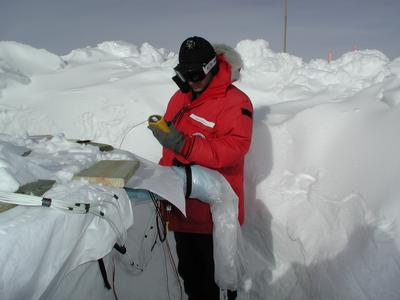13 December, 2001
The water in the tank continues to freeze, but not as nicely as we would have liked. The plan is to control the rate of freezing in way that will allow the water in the tank to freeze completely solid without any cracks or air bubbles. However, this is proving difficult to accomplish due to the large volume of water we are dealing with and the fluctuating temperatures.
Each hour or two, a member of our team walks down to the tank and takes temperature readings. Inside the tank at different locations are a seven thermocouples, a type of thermometer. We record the temperatures received from each thermocouple in order to make assessments about the inner temperature of the tank. Based on our readers, we either lower or raise the temperature of the heating device found in the core of the detector.
As the water freezes, it expands. Expecting this expansion, we have a flow tube for excess water to leave the tank. Without this system, the freezing water would expand so much that it would fracture the tank and ruin the experiment. Despite our efforts, some bubbles are appearing in the surface of the frozen water. Furthermore, a crack has begun to form. We will have to monitor the temperatures more to prevent any further problems. Have irregularities in the surface of the ice is not a problem, but if they develop deeper we will have a problem. Even these initial problems are indicating that the design of the tank may have to be abandoned for future experiments.
Biological Data
Saturated Oxygen: 93%
Pulse Rate: 88
Weather Data
Temperature: -30.0 F
Wind Chill: -62.5 F

Serap analyzing the frozen water for irregularities.

Jason taking temperature readings from the core of the detector.
Contact the TEA in the field at
.
If you cannot connect through your browser, copy the
TEA's e-mail address in the "To:" line of
your favorite e-mail package.
|
